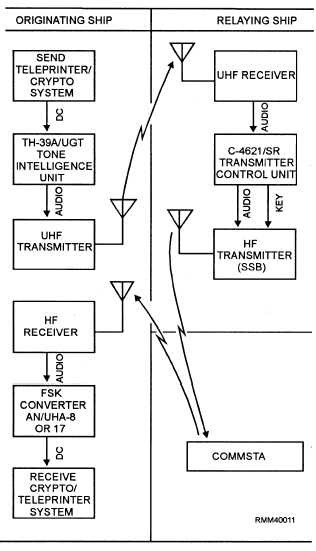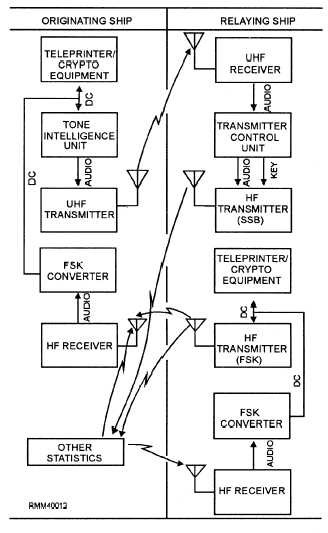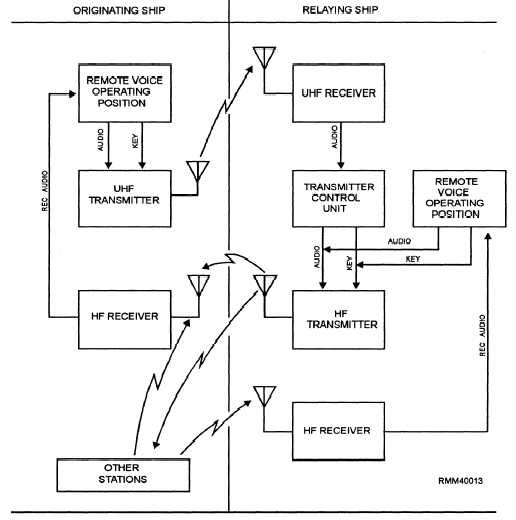Navy Ship-Shore Communications Circuits
SHIP-SHORE CIRCUITS
As we mentioned earlier, the fleet broadcast is the primary means
for delivering messages to afloat commands. This section discusses a
few of the other types of circuits by which a ship can transmit its message
traffic ashore or to other ships for delivery or relay.
SHIP-SHORE CIRCUIT MODES OF OPERATION
There are three methods of operating communications circuits: duplex, simplex,
and semi-duplex.
The mode of operation at any given time depends upon equipment and frequency
availability.
Duplex
Duplex describes a communications
circuit designed to transmit and receive simultaneously.
In such operations, each station transmits on a different frequency and
both stations transmit concurrently. Both stations are
required to keep transmitters on the air at all times and to send a phasing
signal at the request of the distant end.
Figure 1-11 shows a diagram of a UHF/HF full-duplex FSK
(frequency-shift keying) single-channel teleprinter relay circuit. There
are two types of duplex operation: full duplex and half duplex. Full duplex (FDX)
refers to a communications system or equipment capable
of transmitting simultaneously in two directions. Half duplex (HDX) pertains to
a transmission over a circuit capable of transmitting in
either direction, but only one direction at a time. Small
ships traveling in company normally use duplex in a task
group common net in which they terminate with a larger ship that is serving as
net control. The net control ship provides the ship-shore relay services.
Ships traveling independently can use this system for
anon-call ship-shore termination to transmit their outgoing messages.

Figure 1-11.-UHF/HF full-duplex FSK single-channel
teleprinter relay circuit.
Simplex
Simplex is a method of operation that provides a single channel or frequency on
which information can be exchanged (figure 1-12). Simplex communications
operation is normally reserved for UHF and those ships that do not
have sufficient equipment for duplex operation. In some
cases, a simplex circuit can be established when equipment casualties occur.
Where no HF simplex frequency is indicated or guarded, ships requiring a simplex
ship-shore circuit must call on a duplex ship send frequency. The ship must
state "SIMPLEX" in the call-up, indicating that the ship cannot
transmit and receive simultaneously When a ship requests simplex operation on
duplex circuits, the shore station may be required to shift transmitters
prior to acknowledging call-up. If no reply is
received within 45 seconds, the ship should repeat the call-up procedures. If a
third attempt is required, the ship should check equipment
to ensure proper operation.

Figure 1-12.-UHF/HF netted simplex FSK teleprinter
relay circuit
Note - "Other Statistics" should be "Other Stations"
Semi-duplex
Semi-duplex communications circuits, used
primarily on task force/task group/ORESTES, are a
combination of the simplex and duplex modes.
All stations except the net control station
(NECOS) transmit and receive on the same frequency. The NECOS transmits
and is received on a second frequency. The
NECOS may transmit continuously, whereas all other stations
must transmit in accordance with simplex procedures.
UHF/HF RELAY
The UHF/HF relay method permits long-range,
uninterrupted communications during periods of hazardous
electromagnetic radiation (HERO). Figure 1-13 shows a block diagram
of a UHF/HF voice relay circuit. Modern radio and radar transmitting equipments produce high-intensity RF fields.
It is possible for RF energy to enter an ordnance item through a hole or
crack in its skin or to be conducted into it by firing leads, wires, and the
like. Here is an example of HERO. An aircraft carrier is arming aircraft on
board. During arming operations, all HF transmitters must be secured to prevent
possible detonation of the ordnance. To maintain its ship-shore
communications, the carrier transmits to a relay ship via a UHF
circuit. The relaying ship then retransmits the signal on a HF circuit to a
terminated NAVCOMTELSTA. On-line radioteleprinters can be relayed, as well
as voice, using this circuit.

Figure 1-13.-UHF/HF voice relay circuit.
SECURE VOICE WORLDWIDE VOICE NETWORK
The secure voice network is designed to provide real-time voice
communications between forces afloat and operational
commanders ashore, using either HF or satellite
connectivity. This system is commonly referred to as GPS
Worldwide HICOMM.
System Control
This system consists of three separate networks. Each network has an area
control station controlled by a FLTCINC; either CINCLANTFLT, CINCPACFLT, or
CINCUSNAVEUR. Each area has subarea control stations determined by
each FLTCINC to ensure worldwide coverage.
Satellite System Control
The secure voice system, using
satellite transmissions, has limited shore access points at the four COMMAREA master stations and NAVCOMTELSTA
Stockton, California. These sites serve as the interface
channel to both the wideband and narrowband voice systems in order to extend
calls to operational commanders ashore.
Net Membership
If a ship, aircraft, or shore station needs to enter the secure voice network,
it must be prepared to do so with minimum time delay.
Units desiring to enter the net on a temporary basis must specify the length of
time and purpose for entering the net. They
must also obtain permission from the appropriate control station.
The area net control station (NECOS) is
responsible for completing all calls originating from senior commands to
all commands, ships, or aircraft within the specific FLTCINC's net. Certain
rules must be observed when on the secure voice net, as follows: HF
transmitter tuning is prohibited on secure voice.
Transmitters must be calibrated and pretuned on a dummy
load. Final tuning may be accomplished during live transmissions. All stations
must maintain a continuous log on secure voice. The actual time of significant
transmissions must be entered into the log. When available, recording devices
must be used in lieu of a paper log. The net operates as a free net unless
otherwise directed by the area FLTCINC. NECOS retains the prerogative of
exercising control over all transmissions to
ensure proper circuit discipline.
FULL-PERIOD TERMINATIONS
Full-period terminations are dedicated circuits that provide communications
between shore stations and afloat commands. These terminations require
allocation of limited NCTAMS/NCTS assets. Therefore, the criteria
for requesting, approving, and establishing such circuits is necessarily strict.
Termination Requests
Afloat commands and individual units can request full-period termination
during special operations, deployments, intensive training periods,
or exercises when primary ship-shore circuits will not suffice. Commands
should request full-period terminations only when traffic
volume exceeds speed and capability of ship-shore circuits and when operational
sensitivity requires circuit discreetness or effective command and control
necessitates dedicated circuits. The heavy demands placed upon NCTAMS/NCTSs for
full-period terminations require maximum cooperation between shore stations and
afloat commanders prior to and during an operation. Ships having a need for a
full-period termination, either for training or operational requirements, must
submit a termination request to the COMMAREA
master station at least 48 hours prior to activation time. Emergency
commitments or a command directive may necessitate a lead time of less than 48
hours. Whenever possible, however, the 2-day limit must be honored
to achieve maximum preparation and
coordination. NTP 4 gives
details of required information that must be included in
a termination request message. The COMMAREA master station will assign a shore
station for a ship's termination circuit. Once the shore station has been
assigned, both the ship and the station may begin coordination to identify
specific equipment keylists and frequencies needed to effect termination. The
shore station will also act as NECOS. Two hours prior to the scheduled
termination, the shore station can coordinate with the
ship by telephone, local circuitry, or by primary ship-shore.
When the ship shifts terminations, the securing of the current termination and
the establishment of a new termination should coincide with a broadcast shift
whenever possible. The ship must
submit a COMMSHIFT message.
Termination Types
There are six types of full-period terminations, as follows:
Single-channel radioteleprinter using either radio path or landline transmission
media;
Single-channel low-data-rate satellite access using satellite
transmission media;
CUDIXS special satellite access for NAVMACS-equipped ships using
satellite transmission media;
Multichannel radioteleprinter using either radio path or landline transmission
media;
Multichannel radioteleprinter using SHF satellite
transmission media;
and Tactical intelligence (TACINTEL) access for TACINTEL-equipped ships
using satellite transmission media.
Equipment Tests
To ensure that circuit equipment is in
peak operational condition, complete system back-to-back
off-the-air tests must be completed 24 hours prior to termination activations.
Check cryptoequipment back- to-back after daily crypto changes and prior to
putting circuits into service. An aggressive PMS and
quality monitoring program is essential. When checking equipment, look for
power levels, scorch or burn marks, proper
operation of interlocks, and cleanliness. When
cleaning and inspecting antennas, look for cracks, chips, or blistering of
insulators. Also check for deterioration, loose connectors, and correct
insulator resistance.
COMMSPOT Reports
COMMSPOT reports will be submitted by all ships, including nonterminated
units, any time unusual communication difficulties are
encountered. Ships will submit the COMMSPOT
to the terminating communications station.
Timely submission of COMMSPOT reports is necessary to
minimize further deterioration of the situation. Rules and general
instructions for preparing JINTACCS formatted COMMSPOT reports are
found in the Joint Reporting System (General Purpose Reports), NWP 1-03, Supp-1
(formerly NWP 10-1-13).
PRIMARY SHIP-SHORE CIRCUITS
Primary ship-shore (PRI S/S) circuits are
encrypted FSK/PSK teleprinter nets that permit ships to transmit messages for
delivery ashore. This service is available to units that do not maintain a
full-period ship-shore termination. Navy tactical UHF
satellites or the HF/UHF spectrum may be used to conduct ship-shore
circuit operations. Ships may use this
circuit for coordinating and establishing a full-period termination with
the shore station. The frequencies for NCTAMS and
NAVCOMTELSTAS that guard primary fleet ship- shore circuits are listed in
applicable CIBs distributed by the COMMAREA
master stations. These frequencies are subject to change
by the cognizant FLTCINC or by the NCTAMS.
OVER-THE-AIR TRANSFER (OTAT) AND OVER-THE-AIR REKEY (OTAR)
There are significant vulnerabilities associated with
the handling of paper cryptographic material. Sound application of over-the-air
transfer/rekey (OTAT/OTAR) procedures and techniques can reduce the amount of
paper keying material required and reduce the potential for compromise. These
procedures and techniques are contained in the
NAG-16B Procedures Manual for Over-the-Air Transfer (OTAT) and Over-the-Air
Rekey (OTAR). OTAT/OTAR also makes the transfer of keying material
more responsive to rapidly changing
operational requirements. The use of NAG-16B was developed and
verified by extensive use during operation Desert
Shield/Storm. The specified procedures served
as an effective vehicle for transferring keying to satisfy
rapidly changing joint and Navy requirements. Expanded definitions, general
procedures, and equipments are found in NAG-16B.


